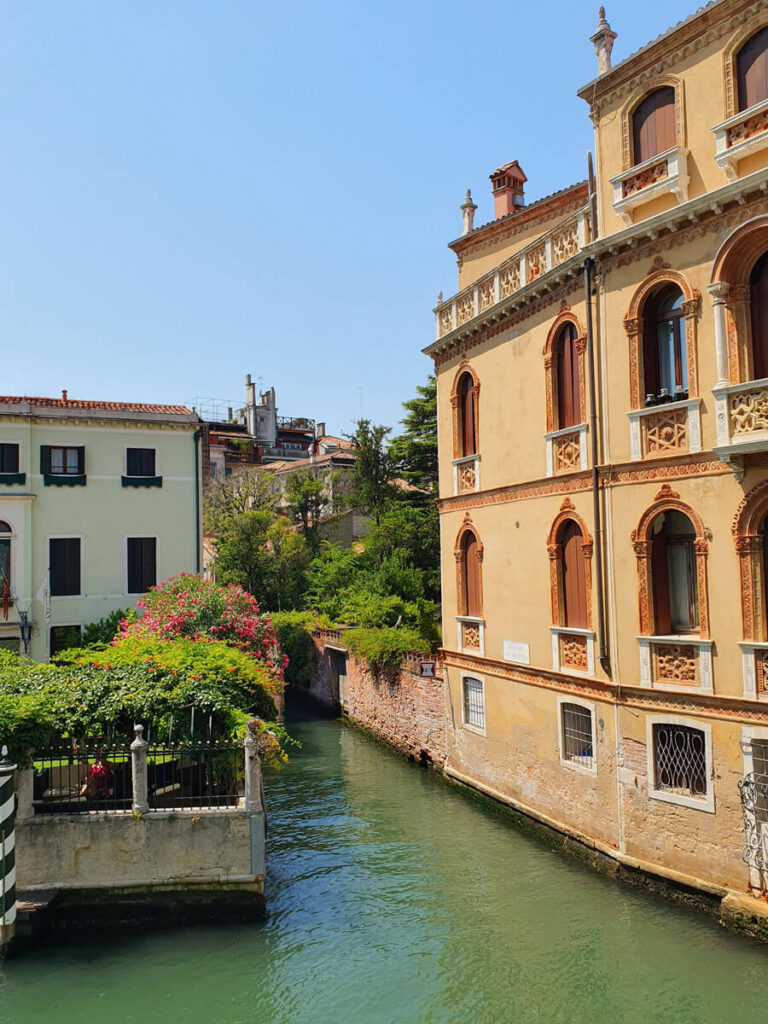In this article I write about finding fabulous ‘secret’ palaces and sights in Venice to visit during the Biennale. Including a ‘vampire palace’ I explored for the first time this year. Although 2024’s Art Biennale is nearly over and some exhibitions have already closed, there is still time for a late visit to others, which stay open till 24th November. The next Art Biennale is in 2026 but in 2025 the Architecture Biennale will probably also offer some off-the-beaten-track sites to explore.
Venice’s huge Art Biennale, held every other year, is a celebration of the contemporary art world. Its two main venues contain a host of national ‘pavilions’ representing art from around the globe. Admission to these is by combined ticket, and you should really allow at least one whole day if you want to experience the show thoroughly (video installations can be especially time-consuming). I’ve been to the Biennale many times and I’ll admit to being pretty jaded about many of the exhibits (I think I reached the limits of my tolerance back in 2011 when I played Biennale Bingo). There are always one or two exhibits which make a visit worthwhile, though.
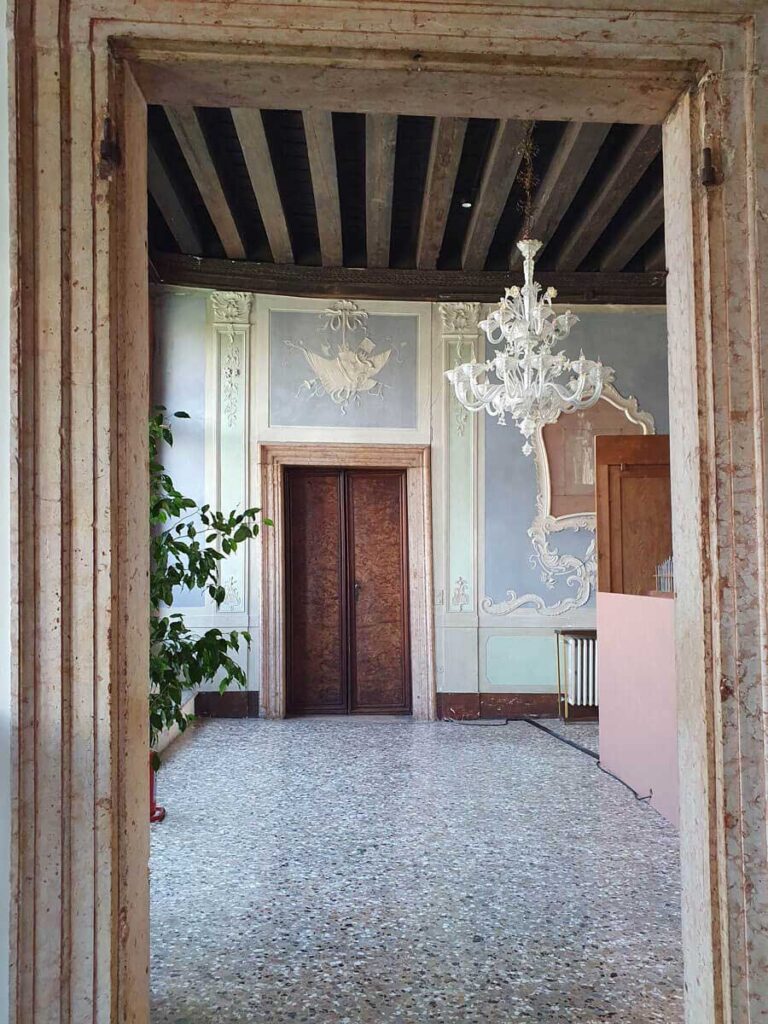
But my real favourite thing about the Biennale is not the art, or not directly, anyway. What I love is being able to visit lots of interesting buildings that are usually closed to the public, including private Grand Canal palazzi and majestic deconsecrated churches. Away from the two main venues, the Biennale also includes under its umbrella a lot of ‘collateral’ events (eventi collaterali). Countries which don’t have their own pavilion at the Biennale site, and thematic art shows which are run alongside the Biennale are housed in spaces all around town. A list or map is published online and is also generally available in pamphlet form at the venues (list of 2024 eventi collaterali). And signs around town will alert you to open buildings and nearby exhibitions.
When I’m in town during the Biennale, I take a look at this map/list and get an idea of any exhibitions I particularly want to visit or revisit, so I can target them on my walks around town. And when I say ‘exhibitions’ here, I mostly mean ‘interesting venues’. I look out for palaces I haven’t visited before, or ones I’m fond of, churches that aren’t usually open, and any site which seems particularly intriguing. But even if you haven’t planned ahead, there is also great pleasure to be had in taking a leisurely stroll through Venice with time to spare, and allowing yourself to be seduced by signposted exhibitions you pass along the way. Banners on the outside of Grand Canal palaces also help to alert you to visiting opportunities.
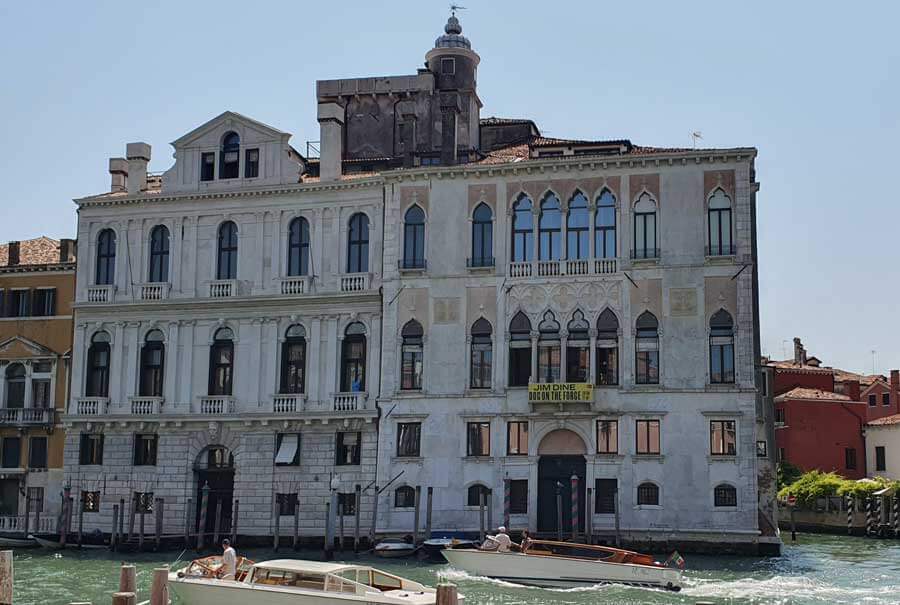
This year in July Venice was far too hot for any strenuous exploring. But pottering at a comfortable pace through the lanes and taking diversions to any exhibition that sounded promising was an ideal way to pass the time. The lack of air-conditioning in many of these venues was the only drawback: a hand-held fan and (refillable) bottle of water are essential touring kit.
Although over the years I’ve visited many of the locations which are regularly hired out as Biennale event venues, this summer I found my way into a number of buildings I’m pretty sure I was touring for the first time. These included a couple of very fine palaces on the Grand Canal, one of which I belatedly realised had a vampire connection I’d overlooked.
The magic of exploring a private Venetian palazzo, admiring its historic stucco decorations, maybe some surviving ceiling frescoes, whatever artworks and furniture still remains, is really special. And each palace on the Grand Canal, of course, has its own unique set of canal views, its own historical associations and usually a fascinating set of stories to research afterwards. I’ve visited palaces in this way before they’ve later been turned into fancy luxury hotels, and I cherish the memories of the faded grandeur and romantic decrepitude of those eras, always aware that the latest palace I’m visiting may be next on the list for a similar transformation that will strip away that atmosphere.
There is so much to enjoy about these artistic opportunities: art, architecture, history, sightseeing and basic curiosity. Venice during the Biennale is a great place for being nosy.
Palazzo Contarini Polignac: home of vampires
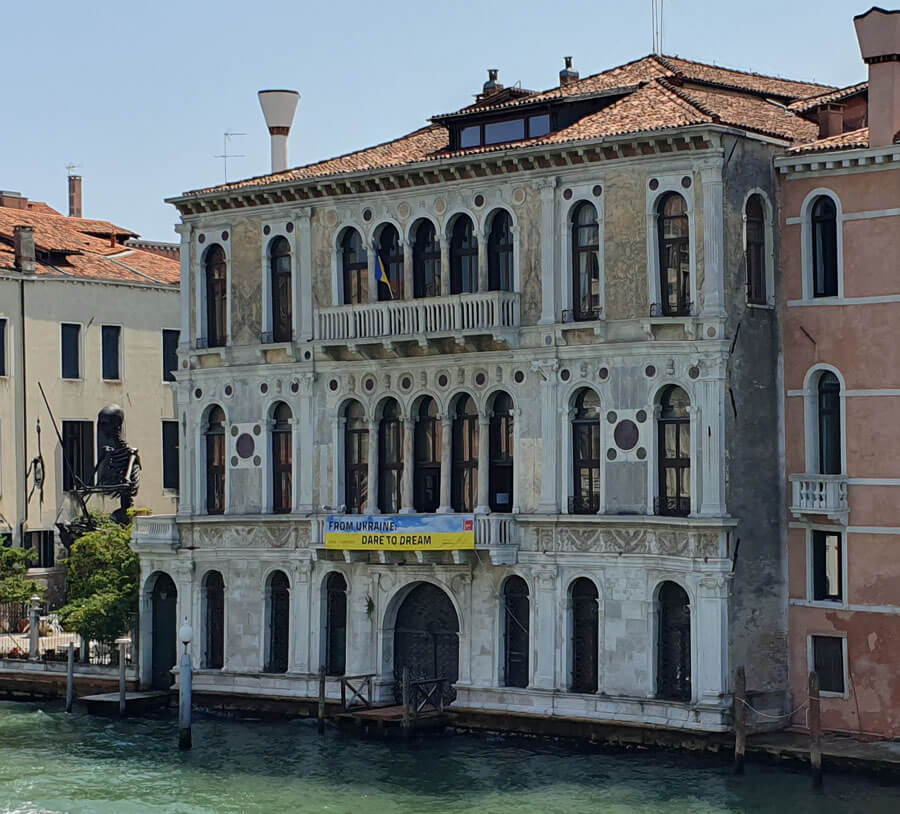
This was a really special visit. This Grand Canal palazzo in Dorsoduro (also known as Palazzo Contarini dal Zaffo) features in the TV vampire drama A Discovery of Witches. I enjoyed the novels – largely because of the entertaining premise in which an epic supernatural struggle begins with problems ordering up a book in the Bodleian Library in Oxford. I’d had already watched the first two series of the TV adaptation some time before, so I was surprised afterwards that I hadn’t remembered that this was a filming location. I only realised this after my visit, meaning I missed the chance to picture menacing, suave vampires as I explored the grand rooms of the palazzo.
In the TV series, this palace is the home of powerful vampire Gerbert, arch-nemesis of the De Clairmont family, and there are lots of shots of the water entrance on the Grand Canal, as well as scenes using the interior of the building and an upper-floor terrace.
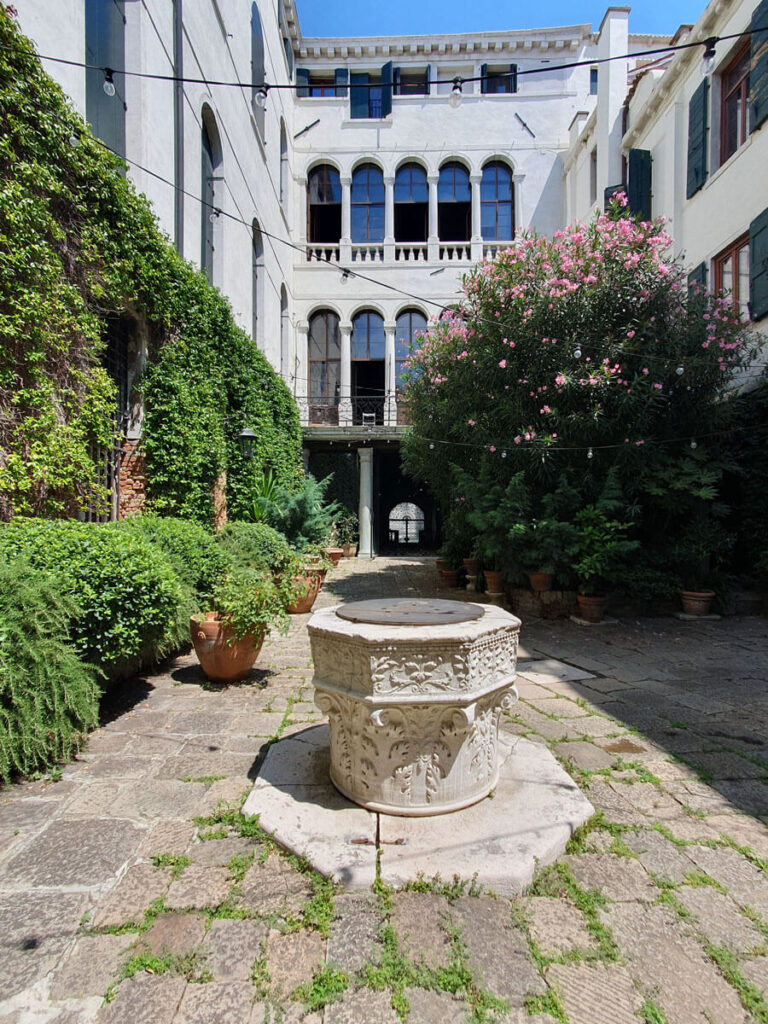
This year the palace housed an exhibition entitled Daring to Dream in a World of Constant Fear or From Ukraine: Dare to Dream. Approached from the rear, land-side entrance via more humble buildings, it was a while before the venue revealed itself in all its faded glory. I passed an aged old felze, the cabin of a historic gondola, which is the kind of thing you still see from time to time standing around in the palazzi where they’ve presumably been left ever since their last use. It was a nice example which still had glass and its decorative interior. These used to have a reputation for illicit behaviour.
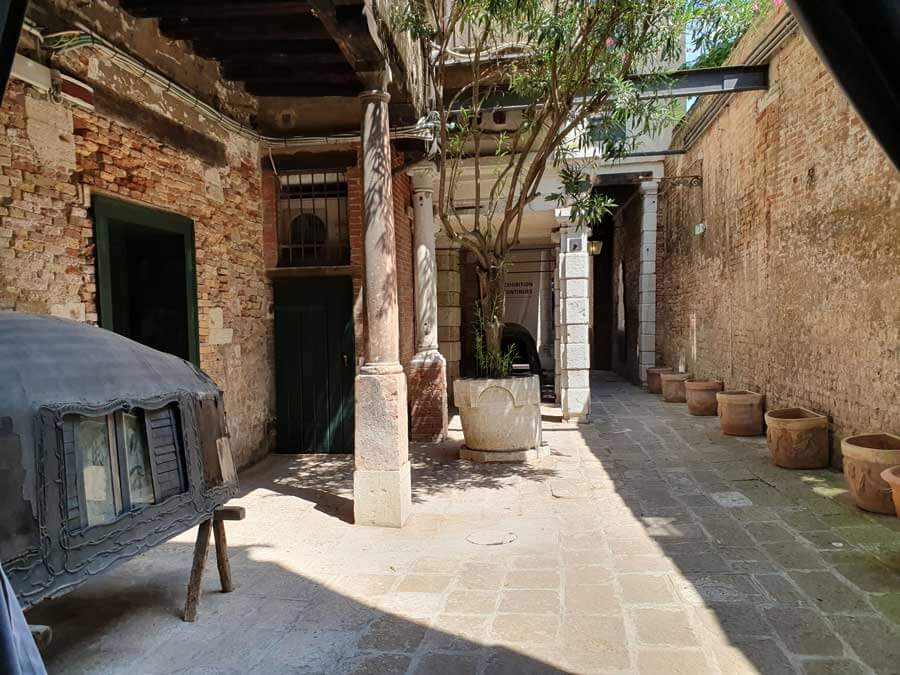
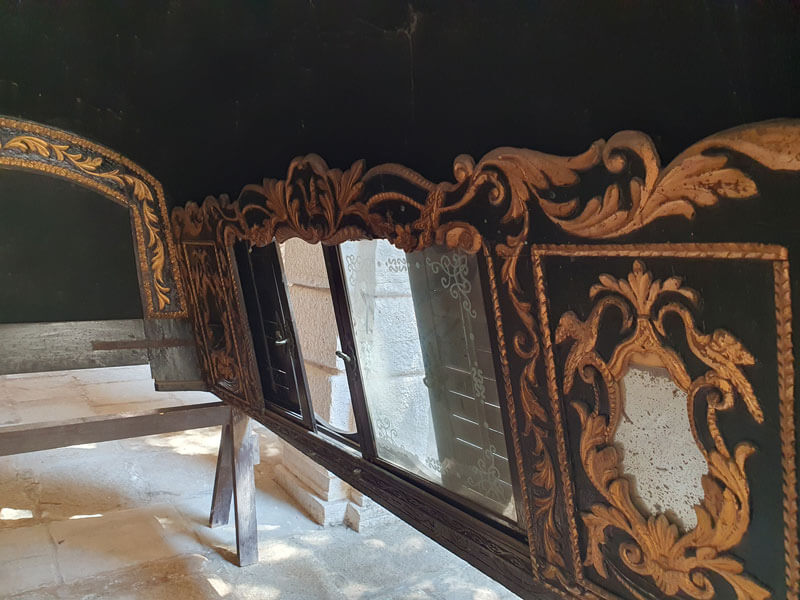
Heading through the various exhibition spaces led me to the hall inside the water entrance of the palazzo, which was used several times in A Discovery of Witches (with added stone floral baskets on the marble balustrade). The palazzo has small courtyard garden with an ornate well head and greenery. Then the exhibition route led up to the first piano nobile. The palazzo has lots of decoration and a great deal to admire and photograph: stucco, paintings, some wooden fixtures and furniture. I’d have loved to know more about some of the art and symbolism on display, though I did of course pay attention to the current contemporary art too.
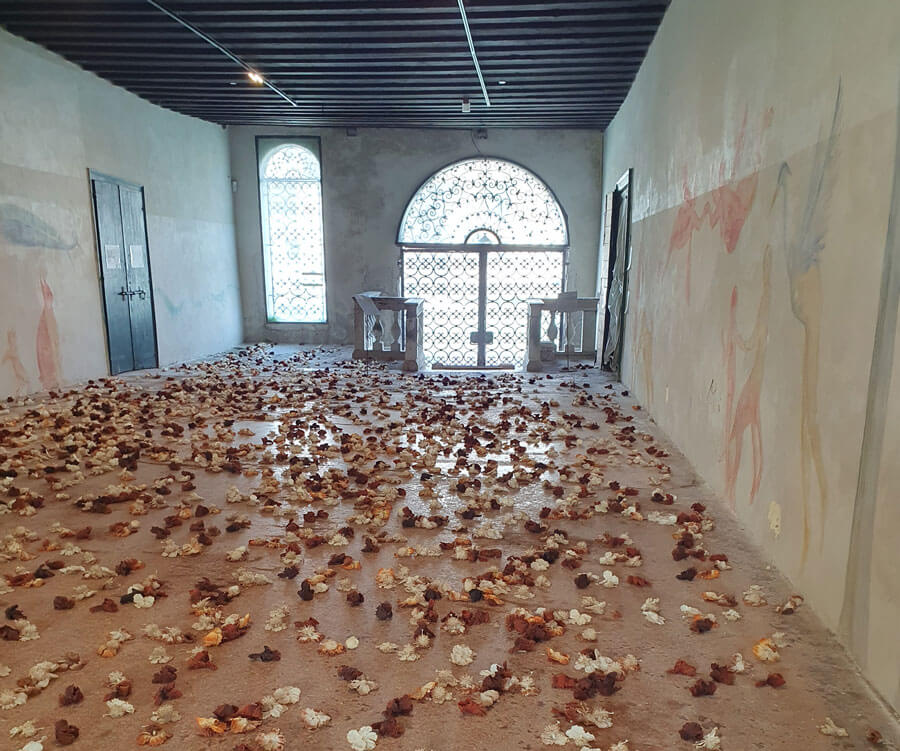
The room with the most striking art exhibit was also the room which is most recognisably featured in A Discovery of Witches.There are several scenes filmed either here or in an on-set recreation of this room, including Gerbert and Domenico’s polite tussle over ‘ownership’ of Venice (along with some tongue-in-cheek references to the city’s overtourism problems). This is a corner room with a mezzanine level, lovely old wall hangings, portraits on the wall and a fireplace. During the 2024 art exhibition the room was dominated by a mound of earth in which roses grew; the artwork Damascus Rose by Fatma Bucak.
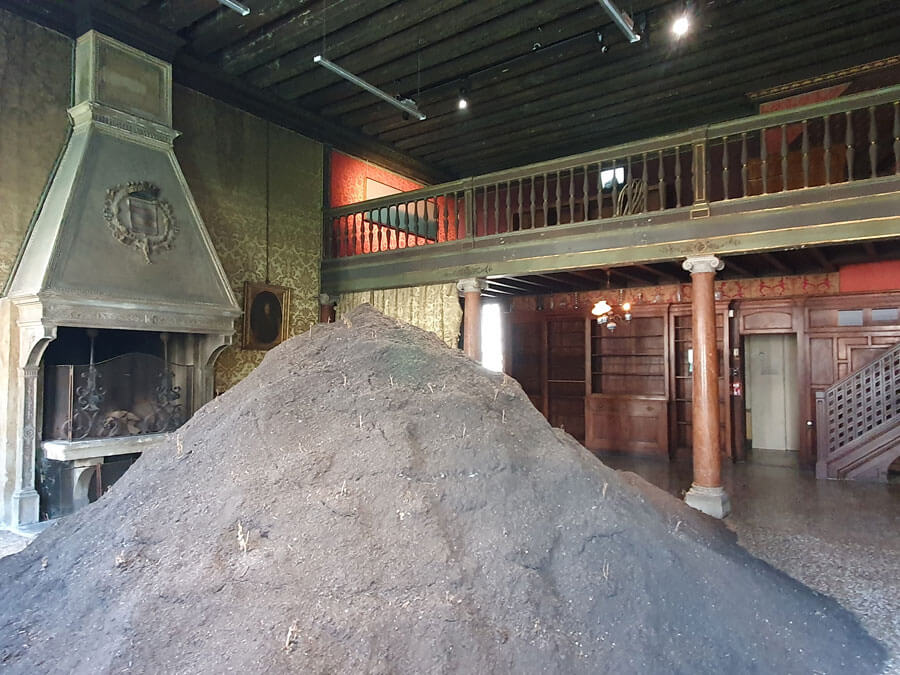
Fictional vampires aside, the palazzo has a fascinating history and I went down a deep rabbit hole reading about former owner Winnaretta Singer (1865-1943), sewing machine heiress, patron of the arts, lesbian and all-round colourful figure, whose family still own the palazzo. A portrait of her hangs inside.
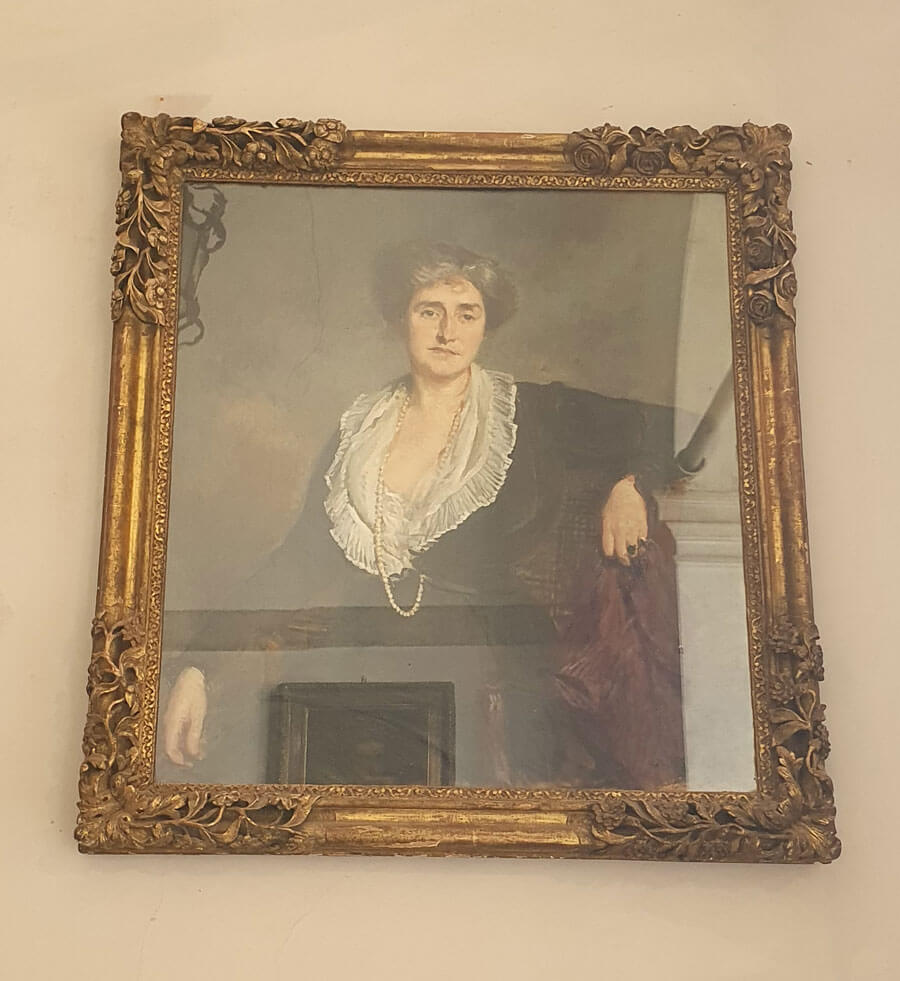
Although Palazzo Contarini Polignac isn’t generally open to the public, it does sometimes host events including the Biennale show I visited. And there is a ground-floor art gallery, the Magazzino Gallery which also puts on contemporary art exhibitions.
If you’re looking for more witch-and-vampire locations, other filming locations in Venice for A Discovery of Witches include San Giorgio Maggiore and its cloisters, the Abbazia della Misericordia, and the Accademia bridge. The French castle of Sept Tours from the novels is actually filmed at the castle of Monselice, not far from Venice, which I’ve previously visited and written about: Monselice.
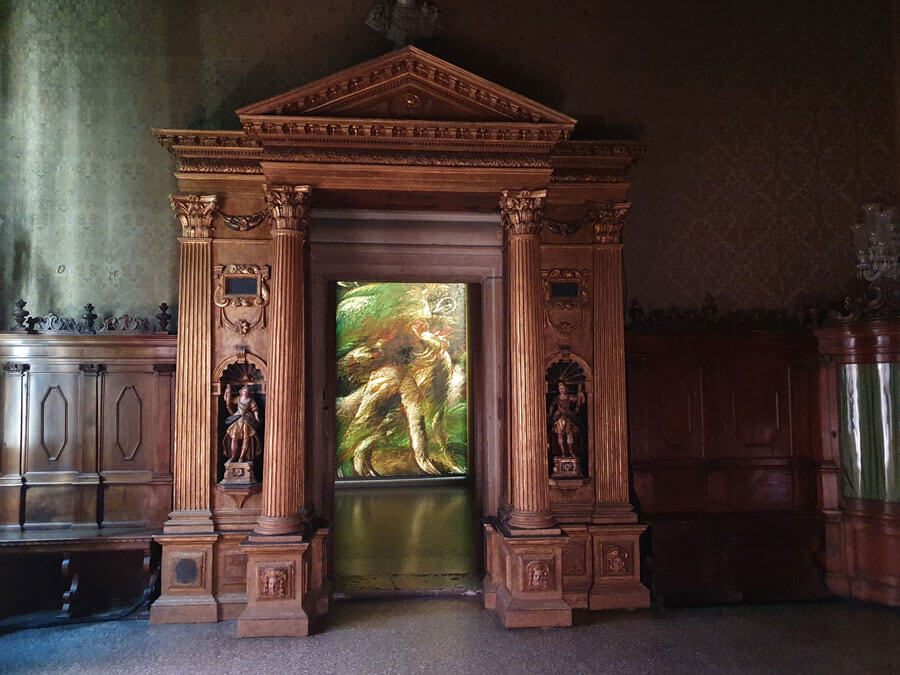
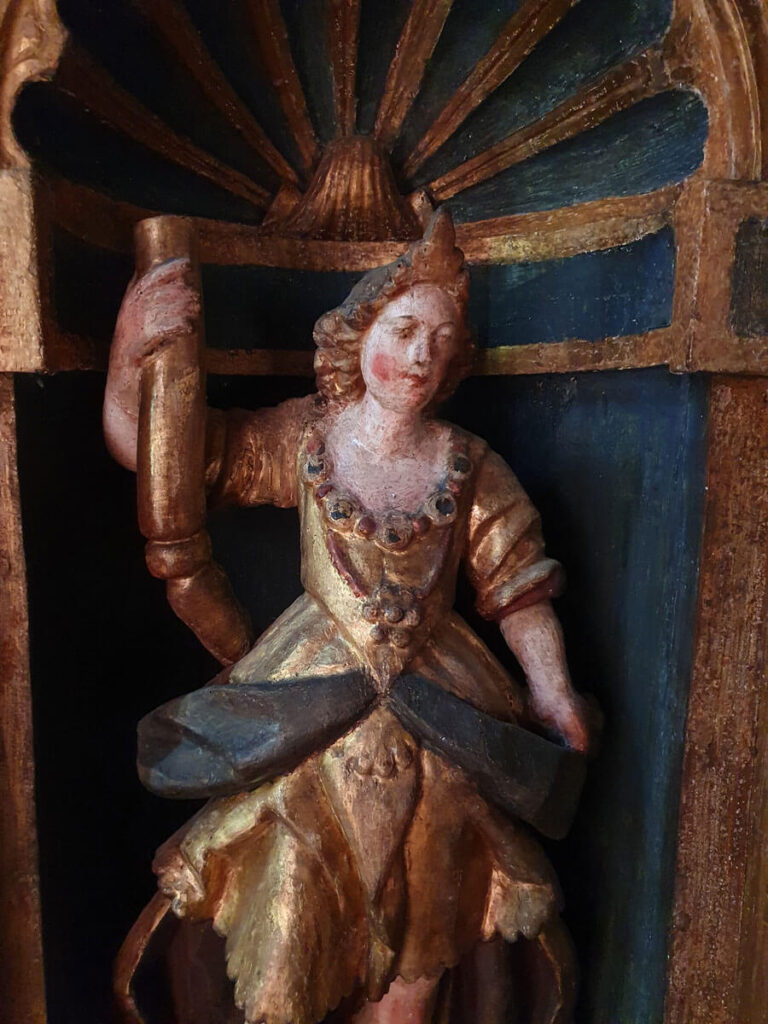
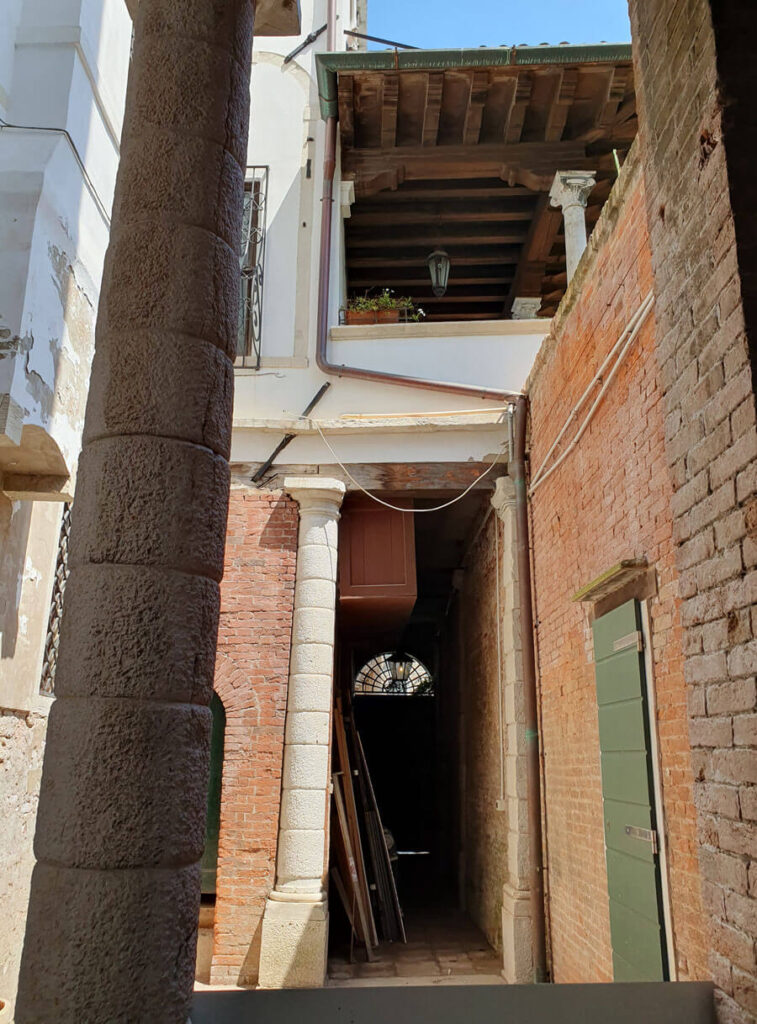
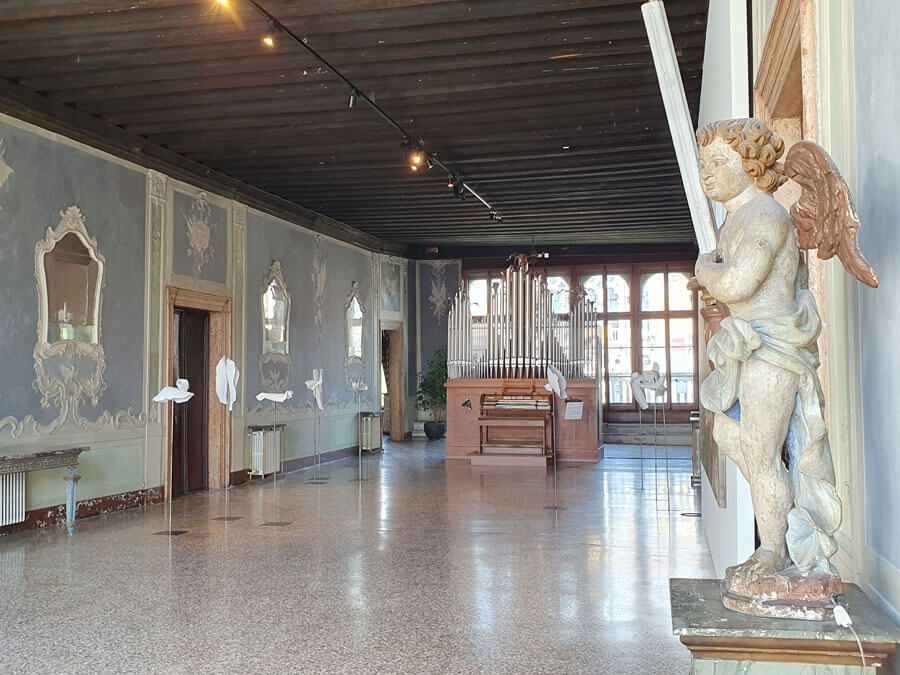
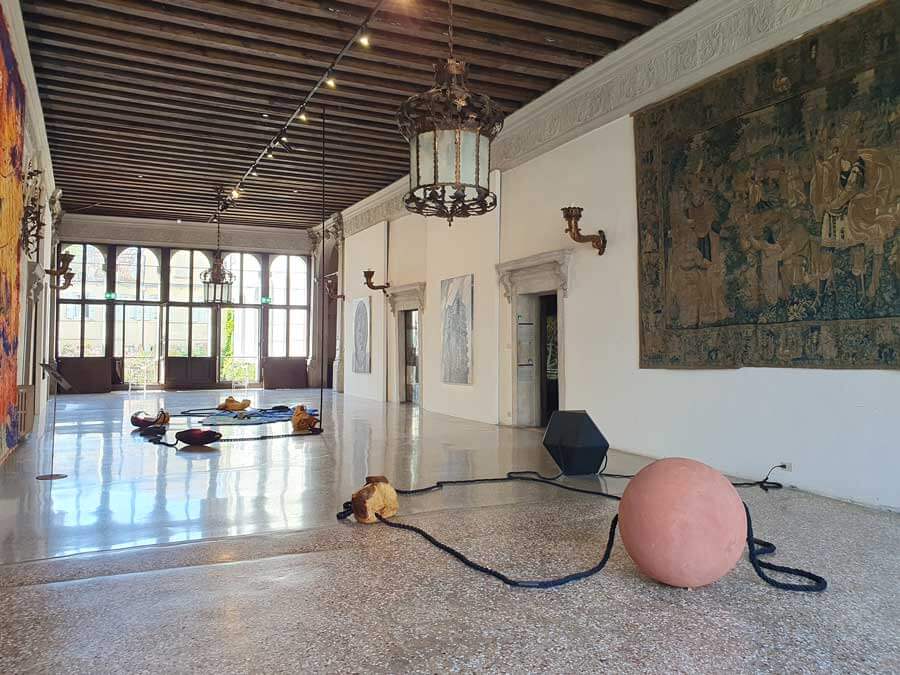
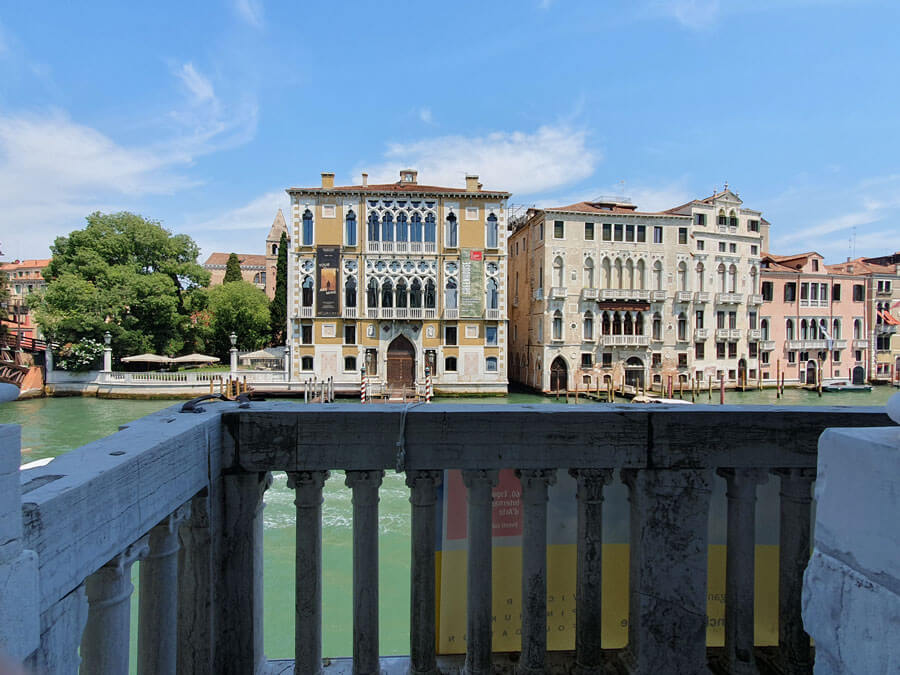
Palazzo Rocca Contarini Corfù
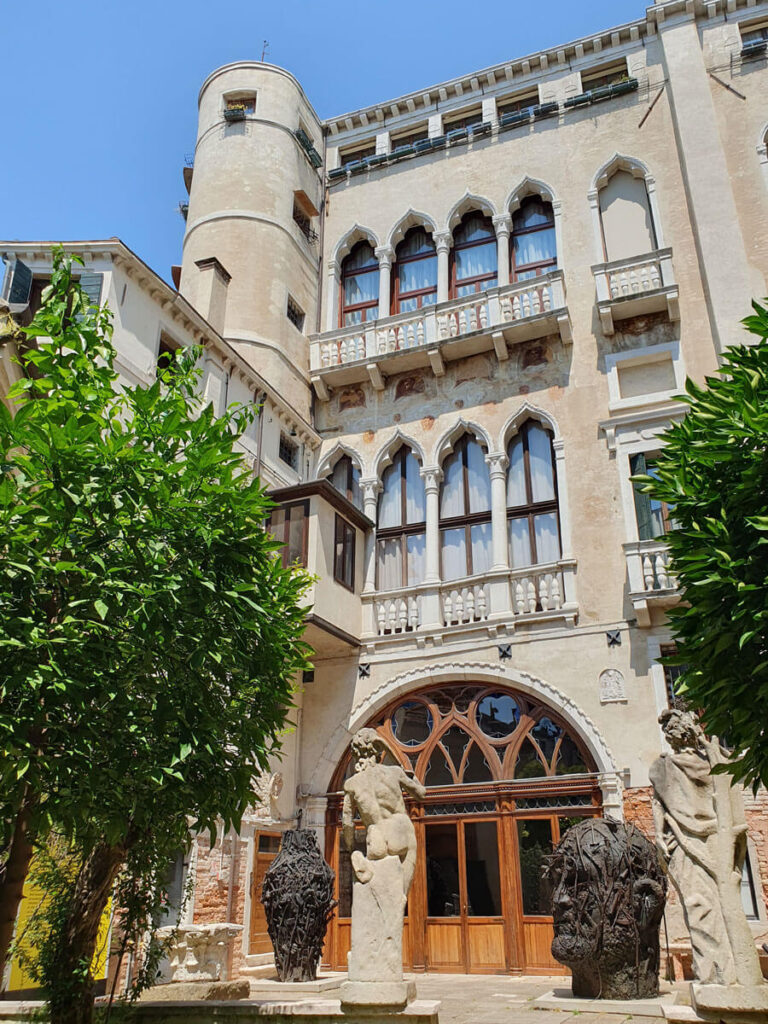
Over the summer this Grand Canal palace in Dorsoduro hosted an interesting exhibition by Jim Dine: Dog on the Forge. The entrance to the palazzo lies on the main walking route through Dorsoduro to the Accademia, a route I must have walked a thousand times, so it was quite thrilling to see a Biennale sign outside, and get past the gate to explore.
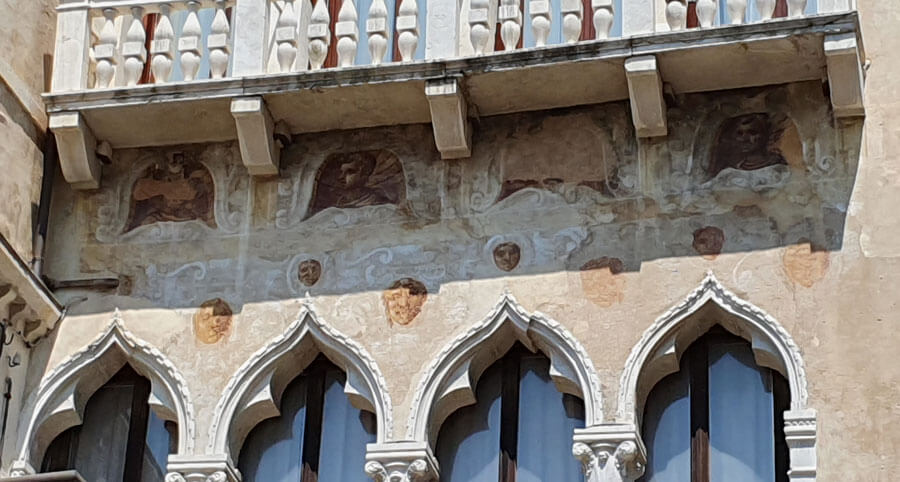
Palazzo Rocca Contarini Corfù take its name, as most Venetian palazzi do, from various past owners. The building dates back as far as the fourteenth or fifteenth centuries, though it underwent significant changes in later eras. The palace still belongs to the Rocca family, who acquired it in the nineteenth century. It hosts private events and visits: http://www.palazzorocca.it/
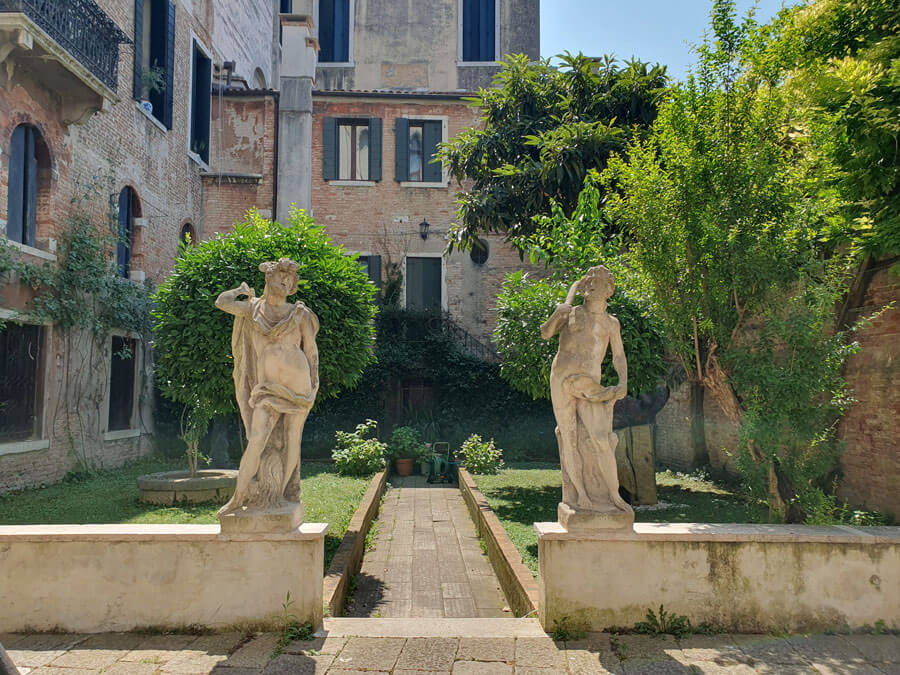
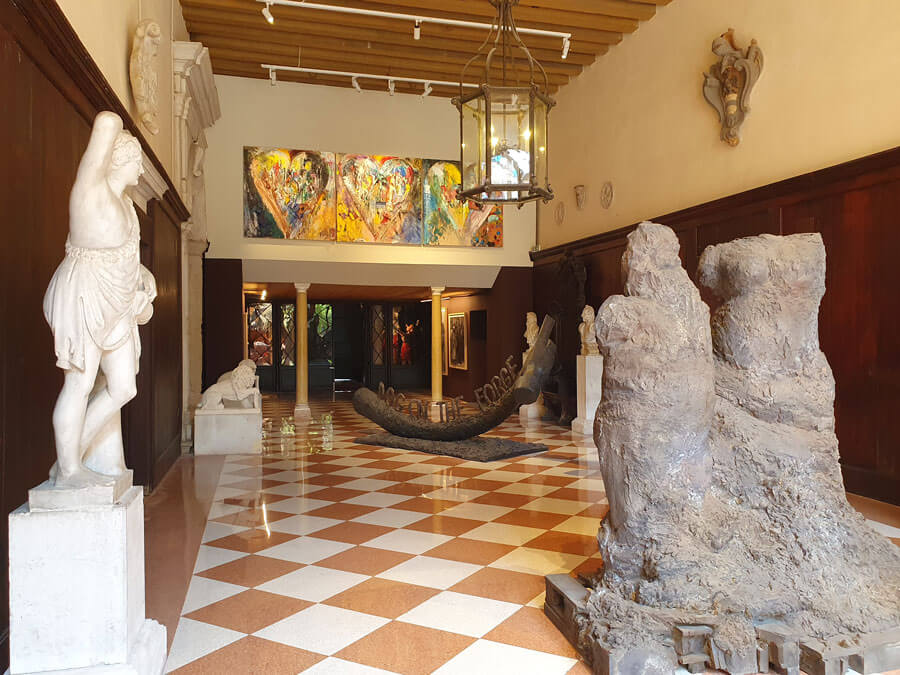
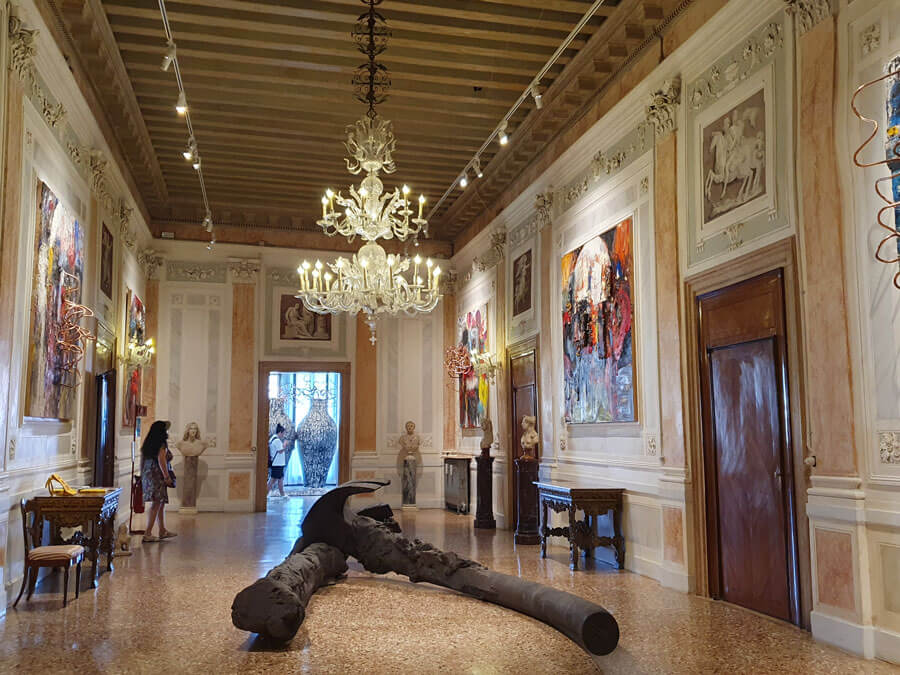
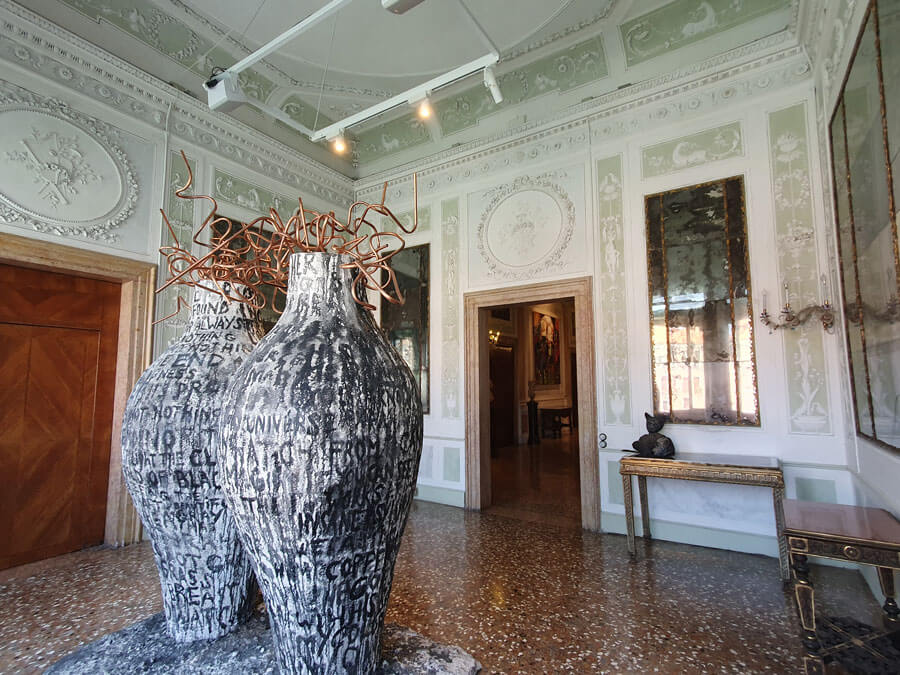
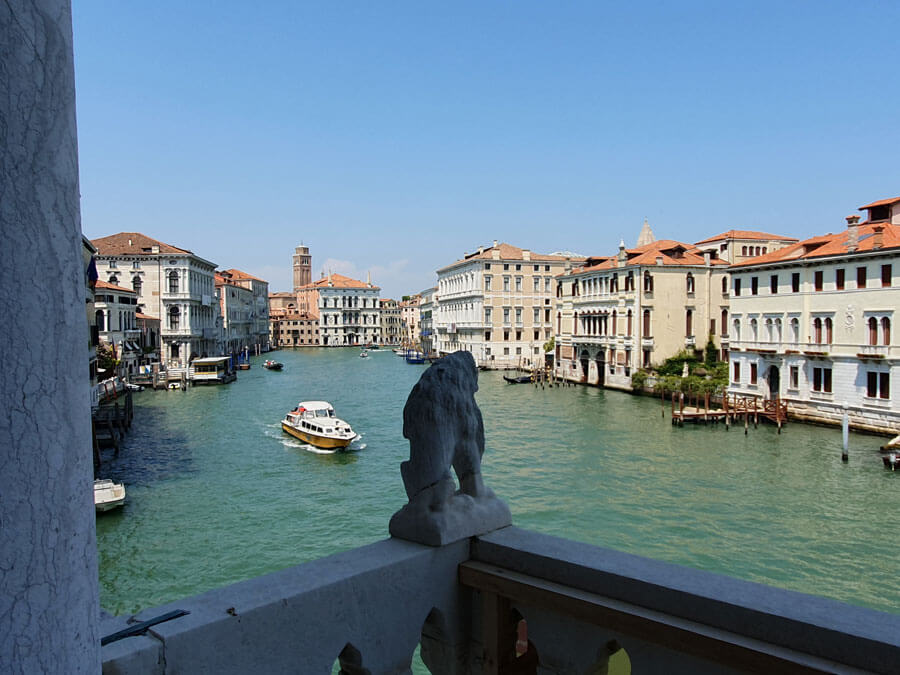
Palazzo Cavanis (Zattere)
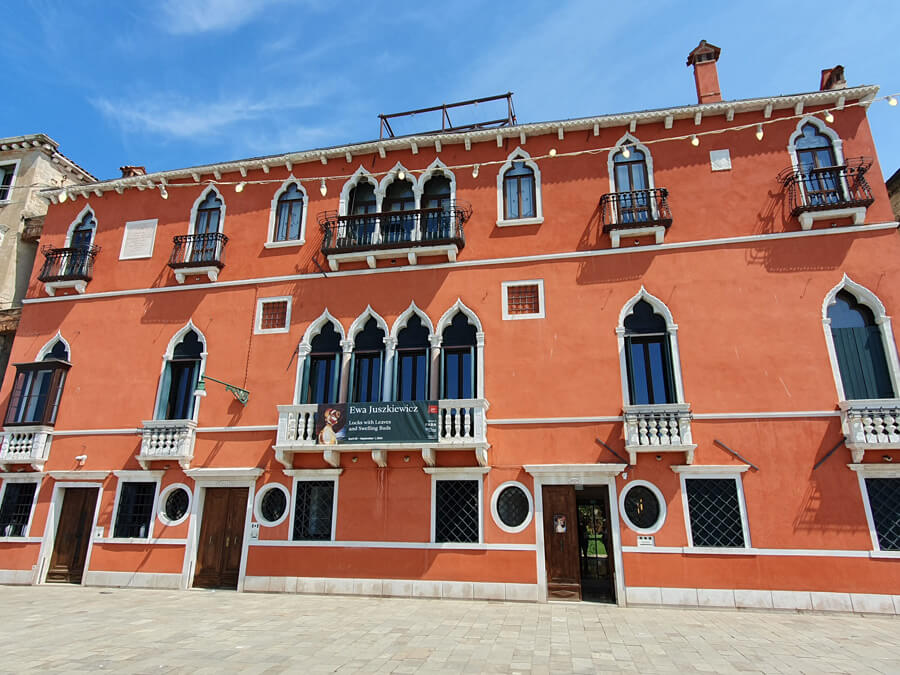
Palazzo Cavanis, on the Zattere waterfront, is smart and restored and I’m not sure I’ve ever looked at it closely before or really appreciated its age, though it features in many photos I’ve taken from the water and the other side of the Giudecca canal. I visited during the exhibition Ewa Juszkiewicz: Locks With Leaves And Swelling Buds, which was both pretty to look at and feminist in its message.
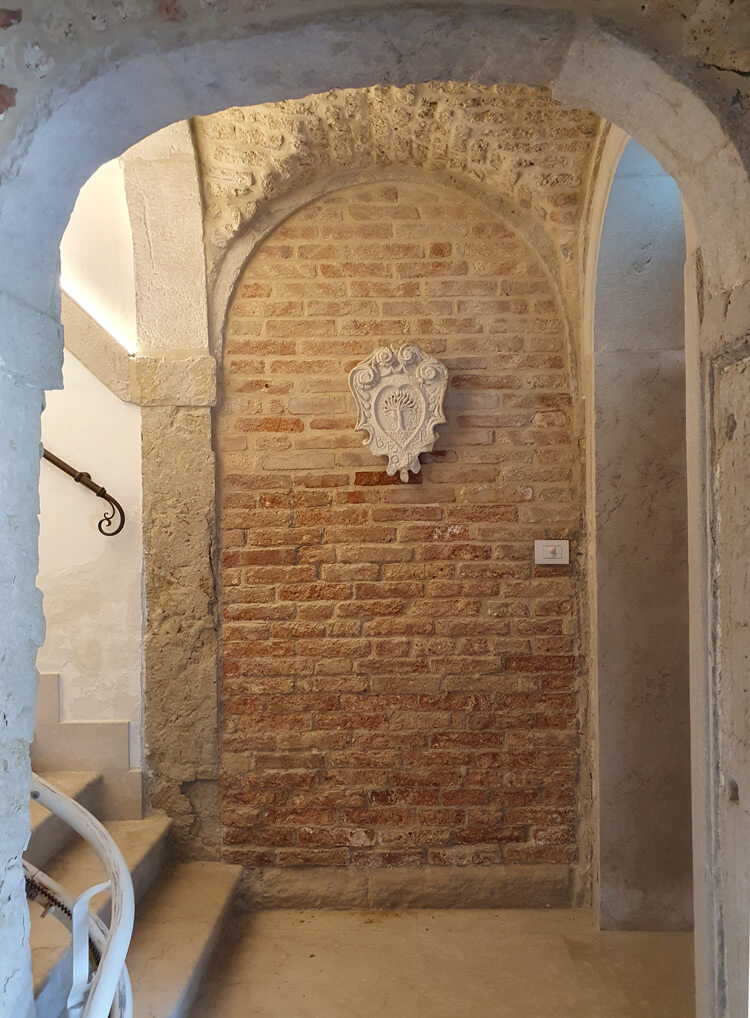
Most of the interior was bare and modern; a blank canvas for the art. But in the architecture and some exposed stonework there was still a record of the building’s antiquity. This was the least interesting internally of the buildings I visited, but still a nice insight into a building I often pass. And the long green garden with an arcade alongside was an attractive surprise.
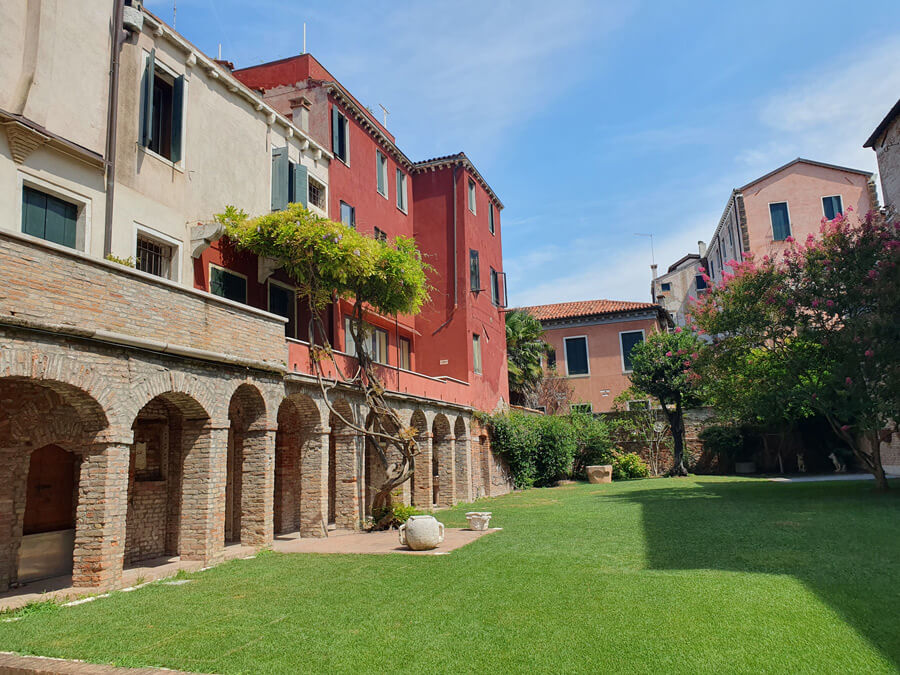
Palazzo Cavanis is hired out as an exhibition space and events venue, and also contains an apartment to rent: https://www.palazzocavanis.com/.
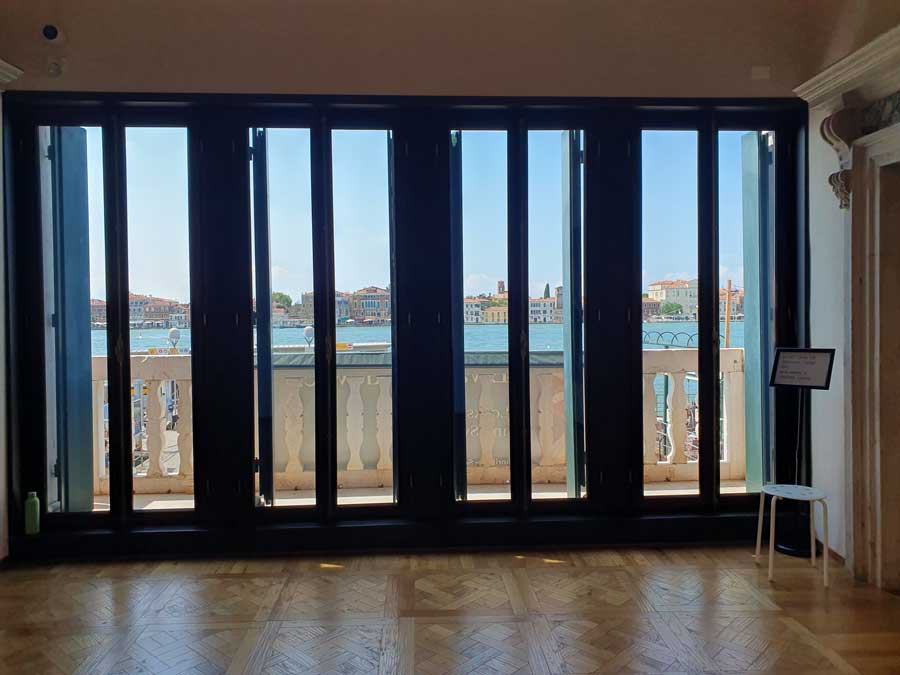
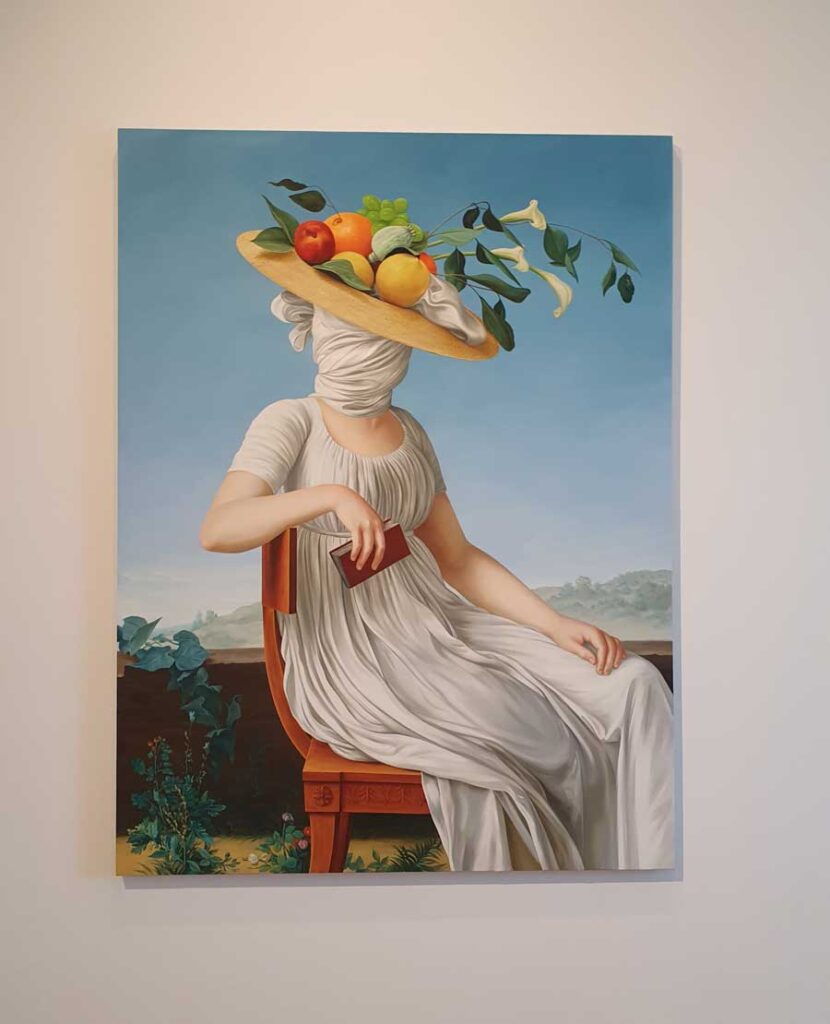
Accademia delle Belle Arti
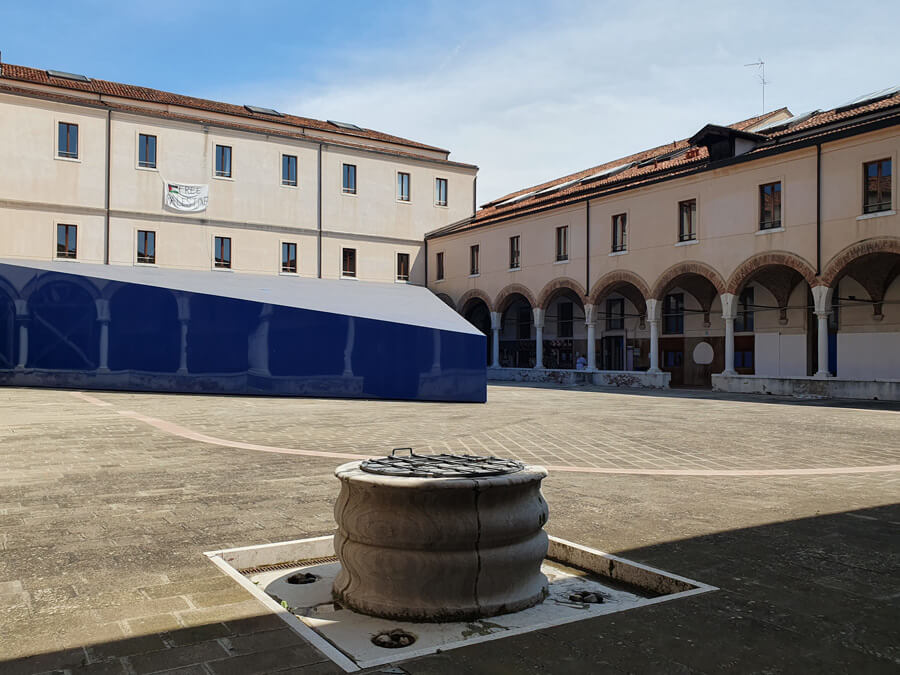
At other times there’s a sign banning tourists from the building. But during this year’s Biennale, this arts university on the Zattere waterfront has welcomed visitors to a Biennale exhibition in a construction in its cloister, Josèfa Ntjam: swell of spæc(i)es
I’d actually visited not long before for a haunting memorial gathering and I think this rather drab, huge courtyard and cloisters will always have a sombre air for me. But it was still interesting to return in a more sightseeing frame of mind.
This immersive art show with a video installation was one of the strangest I visited. I’m not totally sure but I think viewers are swallowed by giant space worm in whose insides we travel before discovering signs of a past civilisation. Though my interpretation may be totally off. You can decide for yourself: the exhibition is open a few days a week until 24th November 2024.
Church of San Samuele
I’ve been exploring Venice for nearly twenty years so I’m not completely sure, but I think that this was the first time I’ve got inside the church of San Samuele. Facing the Grand Canal, with a quaint and old bell tower, this church is associated with Casanova, who spent most of his childhood nearby and entered the priesthood here when a teenager.
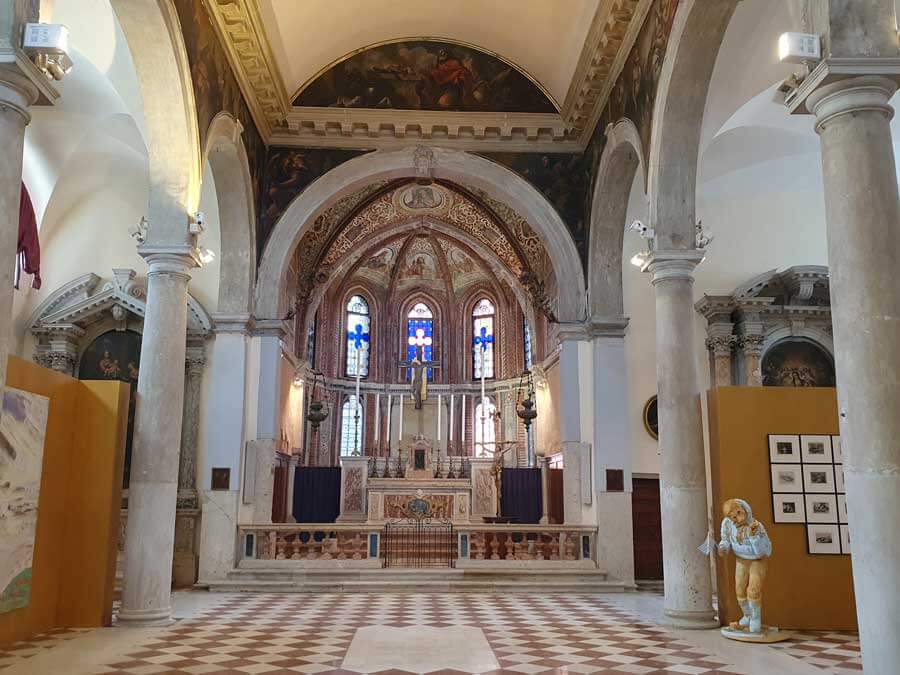
The frescoes in the apse, thought to be from the 1490s, were rediscovered in 1882 and restored by Save Venice in 2001: Frescoes of Christ, the Evangelists, Saints, and Sibyls at San Samuele. The 14th-century crucifix is attributed to Paolo Veneziano. There are a handful of other artworks and curiosities in the church, including a damaged 13th-century icon of the Madonna and Child and its Byzantine silver-gilt revetment.
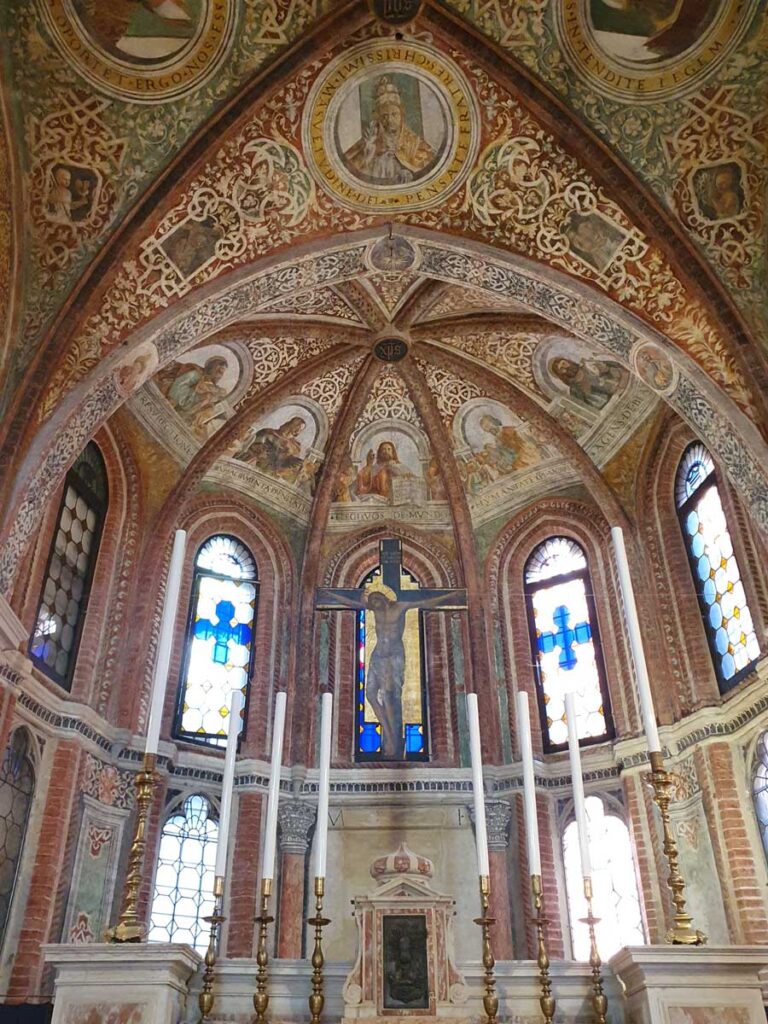
The exhibition in the church was a moving one, titled Beati pacifici: The Disasters of War and the Hope for International Peace.
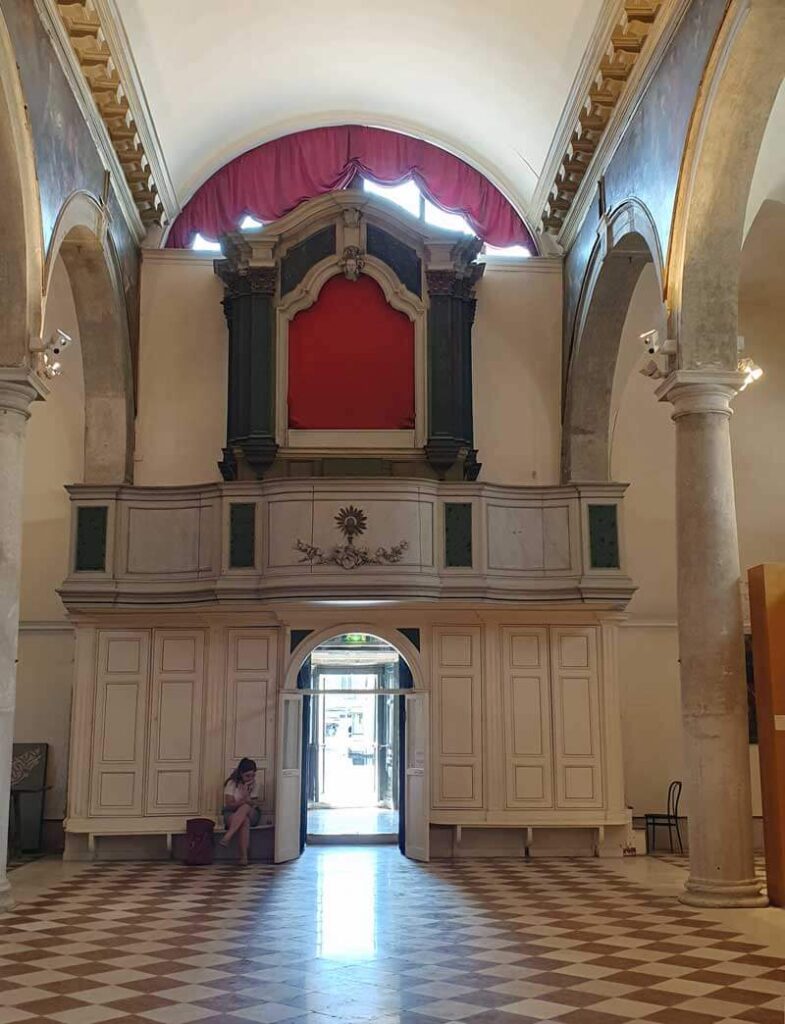
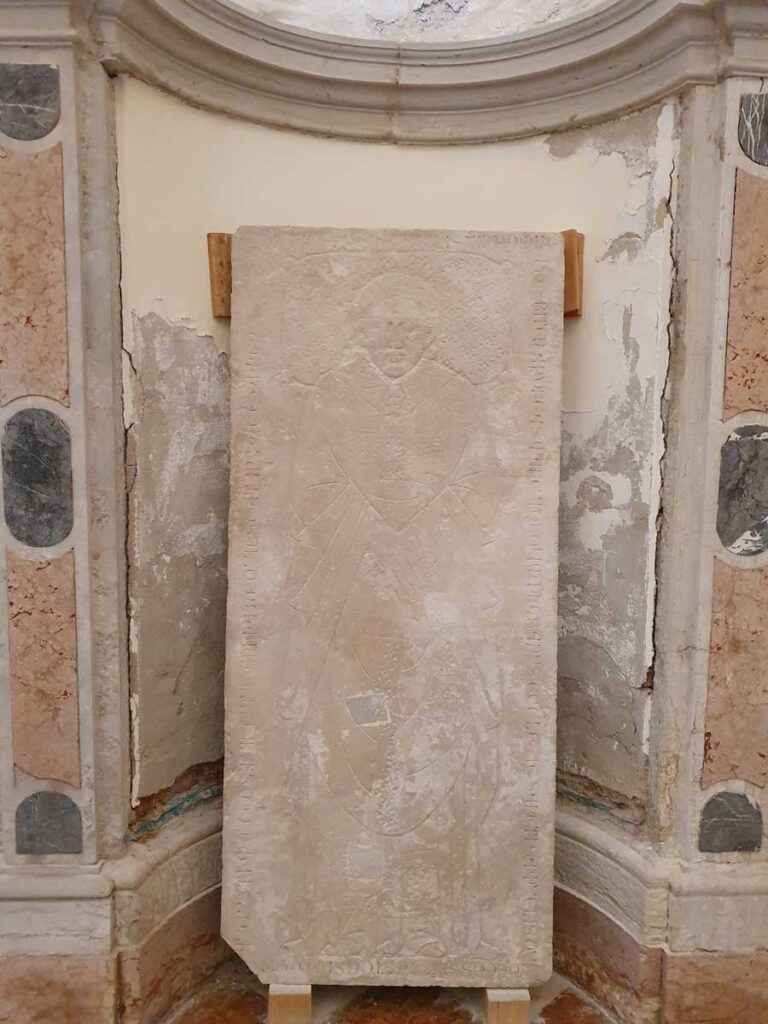
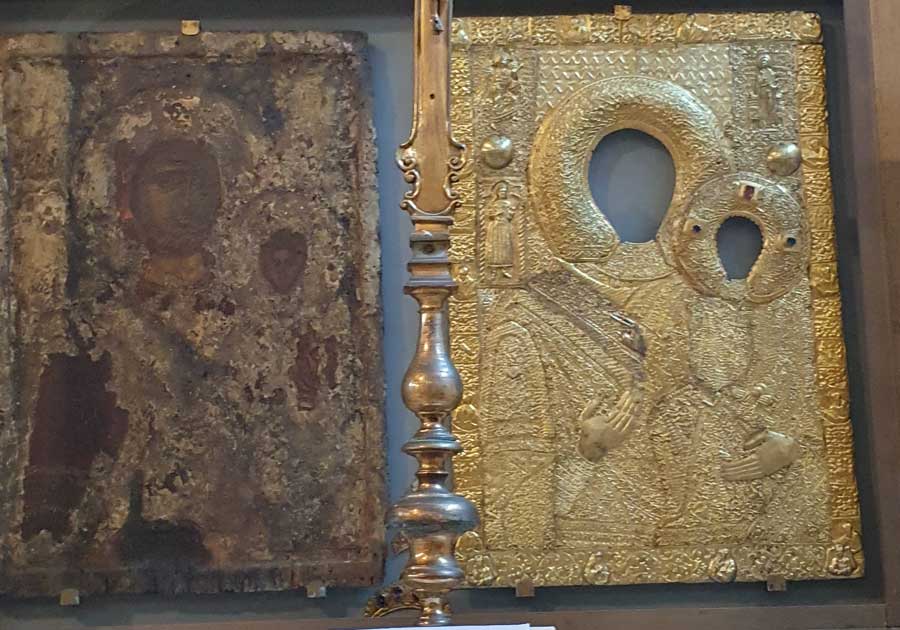
Visiting – and more
All the exhibitions listed above were free to enter. Another fantastic palace with a vast and impressive art installation I enjoyed visiting was the Fondazione Prada, in Ca’ Corner della Regina – but this exhibition costs a rather steep €12 to enter. The exhibition fills several floors of the palazzo and is fascinating in itself, as well as a way to see the palace’s features (some rather obscured by the installation’s set dressing) including wall paintings telling the story of Caterina Cornaro, Queen of Cyprus. This is open till 24th November: https://www.fondazioneprada.org/project/monte-di-pieta/
The Biennale officially runs until 24th November 2024, but do note that some of the exhibitions, particularly the eventi collaterali, have a shorter duration and most of the ones above have already closed (sorry). If it’s too late for this year, bookmark this page to remind yourself to plan your own palace/art tour during the 2026 Art Biennale. Or if you visit during the Architecture Biennale, which happens in alternate summers in between Art Biennales, take a look around, as the set-up is similar, albeit on a smaller scale. And some art exhibitions are held in palazzi at other times too, so if you see a promising poster outside a handsome building, take a look inside: who knows what you will find? I have seen so many of Venice’s private palaces this way.
You can read lots more about Venice with itineraries, walks and more inspiration for getting off the beaten track in my guidebook: Italy Heaven Guide to Venice (Amazon.co.uk affiliate link).
